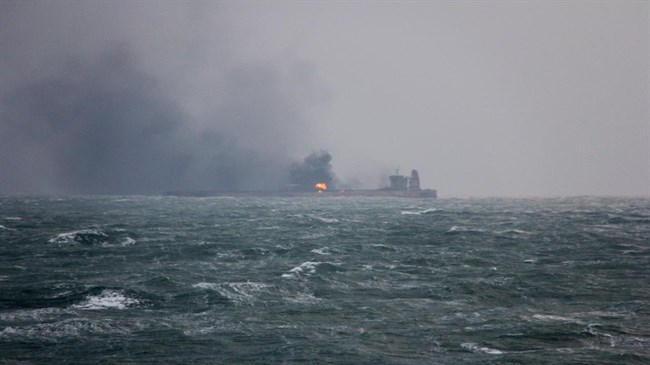
Strong winds, toxic gases hinder search for oil tanker crew
January 09, 2018 - Strong winds, high waves and toxic gases on Tuesday were hindering dozens of rescue boats struggling to locate missing sailors from a stricken oil tanker in the East China Sea and to extinguish a fire that has burned for the past three days on the ship.
The poor conditions, with rain and waves as high as three meters (10 feet), frustrated efforts to tame the fire and search for the 31 remaining tanker crew members, China’s Ministry of Transport said in a statement on Tuesday.
The flames were forcing the South Korean Coast Guard’s search and rescue team to stay as far as three miles (4.8 km) away from the tanker, two South Korean officials told Reuters.
Iranian President Hassan Rouhani in a meeting with ministers of foreign affairs, oil and roads and urban development ordered to use all the national and regional capacities to determine the fate of the missing crew, IRNA reported.
The body of a crew member was found on Monday in the water near the tanker, China’s Transport Ministry said. It had been handed over to the civil affairs bureau.
The crew of the oil tanker are all Iranian nationals except for two Bangladeshi citizens.
The spokesman for the crisis committee said that Iran has dispatched a delegation from the National Iranian Tanker Company (NITC) to China to examine the conditions of the oil tanker.
The other 31 crew members may be caught in the tanker's engine room, Mohsen Bahrami told reporters.
To have access to the crew, the fire should be tamed soon, Bahrami said.
Chinese officials criticized
Chinese officials are very cautious dealing with this issue, so Iran has asked Japan to help, the spokesman added.
Bahrami said an American company had announced its readiness to put out the blaze but it did not have the necessary equipment in the sea nearby.
A US Navy reconnaissance plane joined the hunt Sunday for the 32 sailors. The U.S. sent a P-8A aircraft which searched nearly 3,600 square nautical miles -- but did not find any of the missing crew, the Navy reported.
The Chinese government said late on Tuesday it had not found a “large-scale” oil leak, and the ultralight oil, known as condensate, was burning off or evaporating so quickly it would leave little residue – less than one percent – within five hours of a spill. That reduces the chances of a crude-style oil slick.
Still, condensate is highly volatile when exposed to air and water and concerns were growing the tanker could explode and sink while a flotilla of 13 search and rescue vessels comb a 900-square-nautical-mile (3,100 sq.km) area for the crew.
The tanker Sanchi (IMO:9356608), run by Iran’s top oil shipping operator, NITC, collided on Saturday with the CF Crystal (IMO:9497050), carrying grain from the United States, about 160 nautical miles (300 km) off China’s coast near Shanghai and the mouth of the Yangtze River Delta.
The Sanchi was carrying 136,000 tons of condensate to South Korea, equivalent to about one million barrels and worth about $60 million.
The size of the oil spill from the ship and the extent of the environmental harm were not known, but the disaster has the potential to be the worst since 1991 when 260,000 tons of oil leaked off the Angolan coast.
Satellite imagery of the ship showed the blaze has weakened since the weekend, although the strong winds are dragging the tanker away from the Chinese coast, according to Greenpeace.
The CF Crystal suffered limited damage and the 21 crew members, all Chinese nationals, were rescued by a passing trawler on Saturday night.
“The fire was so fierce. It kept exploding like bombs. So loud,” said Zhu Tingwen, a sailor on the fishing boat.
In the wake of the oil tanker's collision, Iranian insurers are to compensate 30% of the costs while the rest would be covered by a Norwegian firm, the president of the Central Insurance of Iran has announced.
“A Norwegian insurance firm is responsible for covering 70% the tanker’s losses while domestic insurance companies, namely Alborz and Mellat, account for the remaining 20% and 10%, respectively,” Abdolnasser Hemmati was also quoted as saying by CII’s official website.
The official added that half the share of Iranian insurance firms’ risks has been reinsured by the Central Insurance of Iran that also acts as the industry's regulator.
